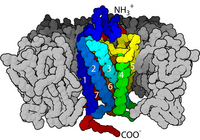
Photo from wikipedia
Ligand receptor based adhesion is the primary mode of interaction of cellular blood constituents with the endothelium. These adhered entities also experience shear flow imposed by the blood which may… Click to show full abstract
Ligand receptor based adhesion is the primary mode of interaction of cellular blood constituents with the endothelium. These adhered entities also experience shear flow imposed by the blood which may lead to their detachment due to the viscous lift forces. Here, we have studied the role of the ligand-receptor bond kinetics in the detachment of an adhered vesicle (a simplified cell model) under shear flow. Using boundary integral formulation we performed numerical simulation of a two dimensional vesicle under shear flow for different values of applied shear rates and time scale of bond kinetics. We observe that the vesicle demonstrates three steady state configurations - adhered, pinned and detached for fast enough ligand-receptor kinetics (akin to Lennard-Jones adhesion). However, for slow bond kinetics the pinned state is not observed. We present scaling laws for the critical shear rates corresponding to the transitions among these three states. These results can help with identifying the processes of cell adhesion/detachment in the blood stream, prevalent features during the immune response and cancer metastasis.
Journal Title: Soft matter
Year Published: 2022
Link to full text (if available)
Share on Social Media: Sign Up to like & get
recommendations!